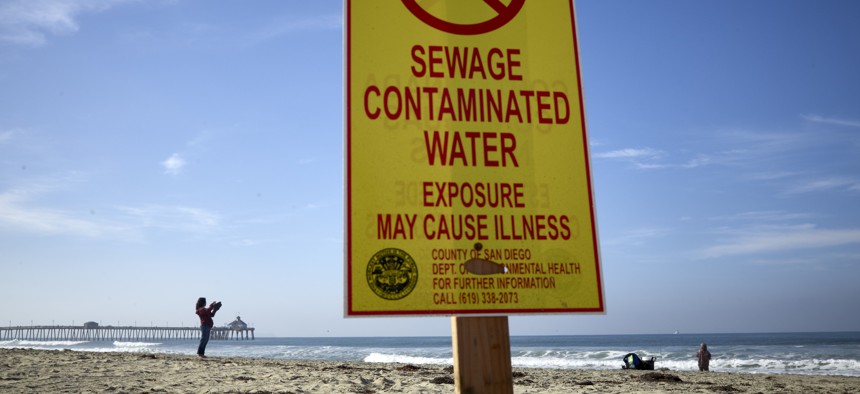EPA Again Targets California, Now Focusing on Water Quality

A woman records with a phone along the beach as a sign warns of contaminated water Wednesday, Dec. 12, 2018, at Imperial Beach, Calif. AP Photo/Gregory Bull

Connecting state and local government leaders
The Trump administration says California is “failing” on water quality, the latest EPA action against the Democrat-led state.
The Trump administration on Thursday said California is “failing to meet its obligations” to enforce water quality standards, tying the violations to the state’s homelessness crisis.
In a letter sent to Gov. Gavin Newsom, the head of the Environmental Protection Agency cited “significant public health concerns” and demanded California address issues regarding stormwater management, human waste and arsenic levels in water.
The water quality letter comes on the heels of a series of other actions that have targeted the Democrat-led state, which previously prompted Newsom to assert that the Trump administration has “weaponized” the EPA.
A spokesman for Newsom on Thursday said the EPA’s latest letter amounts to abuse of power by President Trump.
“This is not about clean air, clean water or helping our state with homelessness,” said Nathan Click, the governor’s spokesman. “This is political retribution against California, plain and simple.”
Earlier this week, the EPA threatened to withhold federal highway funding unless the California proves it is taking steps to improve air quality. That move came just days after the agency announced plans to revoke a waiver that has allowed the state to set its own vehicle emissions standards for more than 50 years. Trump has also recently focused on the state's failures to address homelessness, but housing and homeless advocates have said the solutions offered by the administration wouldn’t solve the crisis in several cities.
The letter from EPA Administrator Andrew Wheeler specifically cites concern with the state’s ability to deal with health concerns stemming from the large homeless populations in cities like San Francisco and Los Angeles. A senior EPA official, who spoke to reporters under the condition of anonymity about the letter Thursday, also cited San Francisco’s combined stormwater and sewage system as a concern because of the potential for untreated water to flow into the Pacific Ocean and the San Francisco Bay.
The letter states that each year San Francisco has routinely discharged more than 1 billion gallons of combined sewage and stormwater into both bodies of water.
“San Francisco, Los Angeles and the state do not appear to be acting with urgency to mitigate the risks to human health and the environment that may result from the homelessness crisis,” Wheeler wrote.
The EPA focus on California comes despite the fact that Safe Drinking Water Act violations, including health-based violations, are pervasive across the country. A Natural Resources Defense Council report in 2017 found that there were 12,000 health-based violations in about 5,000 community water systems in 2015.
Additionally, earlier this month the Trump administration finalized the repeal of an Obama-era regulation strengthening pollution limits of wetlands, rivers, streams and lakes.
That the EPA sent the water quality letter to California so soon after the rollback of the clean water rule has fueled environmental advocates’ skepticism of the action.
“California is not leading the way in terms of water quality violators,” said Michael Kelly, director of communications for Clean Water Action, an environmental advocacy group that opposed the Obama-era regulation rollback. “If EPA were serious about it, they wouldn't be rolling back protections and making it harder for states and local governments to protect local waters.”
Asked if other states should expect to receive similar scrutiny, the EPA official said the letter to California stemmed from concerns raised as part of routine oversight from a variety of EPA program offices.
“What you had here was multiple programs with multiple problems coming at relatively the same time and that triggered concern with the administrator,” the official said about the timing of the letter.
The EPA letter also raises concern regarding the levels of arsenic and lead found in drinking water in the state. Sixty-seven of California's 202 public water systems were found in 194 instances to have levels of arsenic that exceeded the maximum contaminant levels allowed. Approximately 101,000 residents were estimated to be impacted, according to the letter.
In his letter to Newsom, Wheeler requested that the state provide a written response within 30 days to outline how California will address the concerns and violations.
PREVIOUSLY on Route Fifty:
Andrea Noble is a staff correspondent with Route Fifty.

NEXT STORY: A City Called Landlords to Remind Them About Housing Discrimination Laws. Did It Work?




